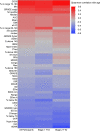OGTT Metrics Surpass Continuous Glucose Monitoring Data for T1D Prediction in Multiple-Autoantibody-Positive Individuals
- PMID: 37572381
- PMCID: PMC10735531
- DOI: 10.1210/clinem/dgad472
OGTT Metrics Surpass Continuous Glucose Monitoring Data for T1D Prediction in Multiple-Autoantibody-Positive Individuals
Erratum in
-
Correction to: "OGTT Metrics Surpass Continuous Glucose Monitoring Data for T1D Prediction in Multiple-Autoantibody-Positive Individuals".J Clin Endocrinol Metab. 2024 Jan 18;109(2):e881. doi: 10.1210/clinem/dgad574. J Clin Endocrinol Metab. 2024. PMID: 37792997 Free PMC article. No abstract available.
Abstract
Context: The value of continuous glucose monitoring (CGM) for monitoring autoantibody (AAB)-positive individuals in clinical trials for progression of type 1 diabetes (T1D) is unknown.
Objective: Compare CGM with oral glucose tolerance test (OGTT)-based metrics in prediction of T1D.
Methods: At academic centers, OGTT and CGM data from multiple-AAB relatives were evaluated for associations with T1D diagnosis. Participants were multiple-AAB-positive individuals in a TrialNet Pathway to Prevention (TN01) CGM ancillary study (n = 93). The intervention was CGM for 1 week at baseline, 6 months, and 12 months. Receiver operating characteristic (ROC) curves of CGM and OGTT metrics for prediction of T1D were analyzed.
Results: Five of 7 OGTT metrics and 29/48 CGM metrics but not HbA1c differed between those who subsequently did or did not develop T1D. ROC area under the curve (AUC) of individual CGM values ranged from 50% to 69% and increased when adjusted for age and AABs. However, the highest-ranking metrics were derived from OGTT: 4/7 with AUC ∼80%. Compared with adjusted multivariable models using CGM data, OGTT-derived variables, Index60 and DPTRS (Diabetes Prevention Trial-Type 1 Risk Score), had higher discriminative ability (higher ROC AUC and positive predictive value with similar negative predictive value).
Conclusion: Every 6-month CGM measures in multiple-AAB-positive individuals are predictive of subsequent T1D, but less so than OGTT-derived variables. CGM may have feasibility advantages and be useful in some settings. However, our data suggest there is insufficient evidence to replace OGTT measures with CGM in the context of clinical trials.
Keywords: CGM; OGTT; prediction; type 1 diabetes.
© The Author(s) 2023. Published by Oxford University Press on behalf of the Endocrine Society. All rights reserved. For permissions, please e-mail: journals.permissions@oup.com.
Figures






References
-
- Steck AK, Dong F, Geno Rasmussen C, et al. . CGM metrics predict imminent progression to type 1 diabetes: Autoimmunity Screening for Kids (ASK) study. Diabetes Care. 2022;45(2):365‐371. - PubMed
Publication types
MeSH terms
Substances
Grants and funding
LinkOut - more resources
Full Text Sources
Medical

